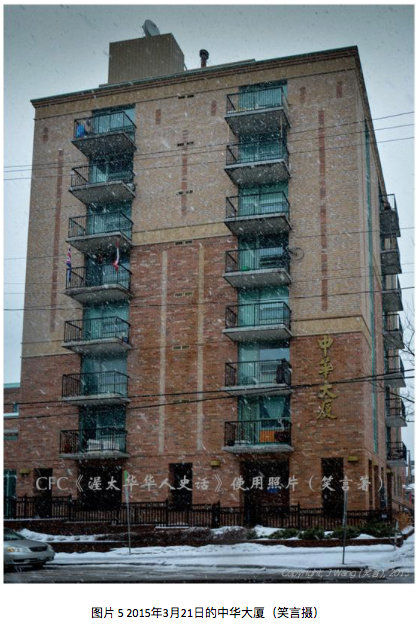Change of terms of office for directors of the Chinese Community Association (1978-1980). On the evening of June 3, 1978, the new 27 directors of the Chinese Community Association were elected from 30 candidates. A total of 299 people voted that day, and 17 of the elected directors were previous directors. The number of votes are in the brackets.
陈炳良 Bing Chan(135)、郑茂源 Anton Cheng(127)、赵中和 Zhonghe Zhao(145)、赵耘清 Vincent Chiu(94)、 周光锦 Guangjin Zhou(92)、方锦波 Jinbo Fang(88)、冯秉持 Bingchi Feng(136)、黄永渠 Robert Huang(81)、 谭连育夫人 Mrs. Lin Yuk Hum(105)、周强安 Bill Joe(134)、龚培滚 Ron Kung(157)、龚仪 Yi Gong(124)、 龚英伦 Ying Lum Kung(85)、关煜彬 Alan Kwan(102)、林安邦 David Lam(109)、李段曼丽 Mary Lee(98)、 李希勣 Paul Lee(88)、李锡荣 Peter Lee(103)、李伟文 Wei Man Lee(93)、李钰祥 Y.C. Lee(81)、劳帮 Bang Lao(B94)、 周日洪 Jack Sim(108)、萧光中 Guangzhong Xiao(82)、谭应为 Yingwei Tan(149)、谭毓民 Yumin Tan(79)、 蔡锡培 Harry Toy(99)、余辉时 Jason Yee(194)
Alternate members: 张重光 Zhang Chongguang, 司徒溢 Peter Seto. Three of them received 79 votes, and the result was decided by drawing lots.
To ensure a fair and just election, the election committee stipulated no candidate could take part in the on-site election work. Instead, the election committee invited people from all disciplines, united church pastors and parishioners, staff from the Overseas Chinese Service Office, and some students to serve as election workers. They also prohibited candidates from distributing flyers at the election site for electioneering.
In July 1978, the new board of the Chinese Community Association held a board meeting. Jason Yee, who immigrated to Ottawa in 1962, was elected President of the Board. The vice-chairpersons were Tan Yingwei and Bing Chan, the secretary was Feng Bingchi, the treasurer was Ying Lum Kung, and the executive committee members were Bill Joe, Ron Kung, Wan Guangzhong and Zhao Zhonghe.
During the meeting, Jason Yee expressed two hopes. One was to raise the societal status of the Chinese Community Association and the local Chinese, which was not very practical. The other was to construct a new clubhouse, which was a realistic goal. Even though the first goal seemed unrealistic, the council took action by founding the Chinese-Canadian Community News and producing the Chinese TV program. The launch of these two Chinese media served the purpose of conveying information about the Chinese Community Association, reaching out to the Chinese community, and establishing a new image for the Chinese.
1978, October 21st was the date of the 20th-anniversary celebration of the Chinese Community Association. The event was held at the Beijing Grand Restaurant and all three levels of government officials attended the dinner party in Ottawa. The celebrations lasted for a week, including the “Rihong Cup” Ottawa Open Table Tennis Tournament, entertainment programs, an all-Chinese dinner party, and a call for articles for the 20th-anniversary special issue.
Jason Yee wrote in his article “A Four-Year Review of the Work of the Chinese Association,” that “in order to maintain close contact with our compatriots, the Board of Directors decided in May 1979 to allocate funds for the establishment of the Chinese-Canadian Community News. Everyone knows it is not easy to run a newspaper, but it is impossible to promote the affairs of the association without a media source.”
Professor Du Yunzhi, who had worked in journalism in Taiwan for over 20 years, moved to Ottawa. He had rich experience in running newspapers. After Jason Yee’s repeated requests, Du Yunzhi agreed to take charge of the founding work. They launched the newspaper on July 20, 1979, and became the official newspaper of the Chinese Community Association, striving to “take a clear position and speak impartially." In its “Founding Statement”, the newspaper stated that it was not a private newspaper. The Mayor of Ottawa, members of Parliament and Chinese from across disciplines congratulated the newspaper on its launch. Although, it is called a newspaper, it is a 40-page publication with the spine on the right and the pages turn from left to right.
In the same year, the Chinese Association produced the “Chinese TV Program” to promote the Chinese Community Association and report on the activities of the Chinese community. Around 1982, the Board of Directors of the Chinese Community Association changed the name of the program to “Canadian Chinese Television”. The program later became a multicultural cable TV program, independent of the Chinese Community Association. On October 5, 2008, an author was interviewed by the host of this program, Ms. Ding Mansu, on the topic of immigration in their new novel, The Flame, and their previously published novel, Walking Without Shadows.
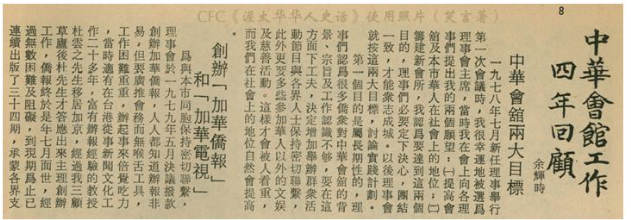
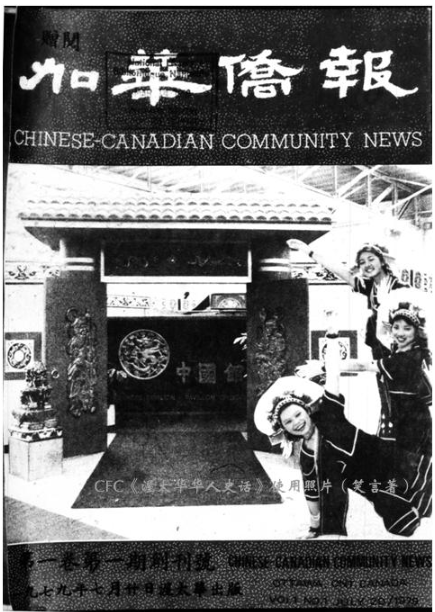
Jason Yee’s second goal at the council meeting was to construct a larger meeting location.
He set this goal in response to the fact that the Chinese population in Ottawa had increased dramatically to 9,000, including about 5,000 adults, and that the old hall at 437 Gilmour St. was no longer sufficient. All the directors voted in favour of the idea and decided that Bill Joe would lead the research for the new clubhouse’s preparation (the term was an investigation at that time). In addition, Li Yuxiang, Bing Chan, and Tan Yingwei would assist in the investigation.
Bill Joe and others investigated for months but could not come up with a good plan. The Chinese Association could not raise enough money from the Chinese community for the purchase of land and construction of a meeting place that could accommodate hundreds of people. Furthermore, the annual maintenance fee would also be in the tens of thousands of dollars, which the Chinese Community Association did not have the financial capability to pay. Meanwhile, the construction of a senior care home was also an issue for the association due to being hampered by the lack of funds.
When there was not much they could do, Li Yuxiang called Jason Yee and said that the federal government was looking at a “non-profit housing allowance plan,” which would probably be implemented by mid-1979. Jason Yee valued this news and immediately called the research team members to discuss it. Starting in the spring of 1979, Jason Yee and his research team went around, looking for relevant information and actively liaising with dignitaries at all levels of government. They first visited Marion Dewar, the mayor of Ottawa, to seek her support. Dewar was the mayor of Ottawa from 1978 to 1985, and he extensively supported the Chinese community. The research team then contacted Mr. Robert de Cotret, the then MP for Ottawa-Centre and later Minister of Regional Industrial Expansion and received his support. He contributed to the successful construction of the “zhonghua” building. The Ontario Ministry of Municipal Affairs and Housing, Mr. Bennett, was also extremely helpful. In short, it would have been almost impossible to build the Zhonghua building without the help of federal, provincial, and municipal government officials.
The research team was later transformed into the Building Committee. In the early stages of planning, they held weekly meetings, and the committee had to go out to the relevant departments to complete various procedures. Jason Yee described the hardships by saying, “I don’t know how many times we have been at the doors of the Central Loan Bureau (CMHC), City Hall, and other related agencies.”
The preparations went smoothly. Collecting information, investigating public opinion and forming the new company were coming along step by step, however the project blueprint, as well as the design and budget, could not be implemented without a building site. The loan from various levels of government wereyet to arrive. What should we do? The time had come to test the leaders’ courage and boldness.
This vital and courageous decision involved lots of risks, and if the construction failed, many people would lose all their years of savings. After several months of entrusted selection by several Chinese property brokers, they concentrated on five lots. Several of the lots exceeded $250,000, a price that was beyond the budget of the Chinese Community Association. The most realistically priced piece of land was only 10,000 square feet in size. This was not the most appealing option, but it was the least expensive. It had a purchase price of $140,000, which was about half the price of the other sites.
The Project Committee began to market the building and seek funding when the research and design were completed. Chinese from various walks of life contributed to the fundraising efforts, particularly the elderly Chinese, who were exceptionally generous. The amount of fundraising exceeded the goal by nearly $50000 CAD.
An advertisement in the April 1, 1979 issue of the Canadian Oversees Chinese News was already accepting applications for residents of the building: "Zhonghua building apartments is now accepting applications for residents. Fifty units. One, two, and three-bedroom apartments are available. To be completed in ten months. ”
According to the Chinese-Canadian Community News, as of July 20, 1979, over one hundred people had filled out pre-registration forms to apply for occupancy. At this point, the building’s address had not yet been selected and was still debated between three downtown sites. Although there were only 50 units in the building and the number of applications had more than doubled the number of rooms, the Chinese Community Association did not reject new applications, promising to conduct a fair review in the future and to reasonably allocate the building to Chinese in urgent need of housing and those with lower incomes.
The original intention of constructing the edifice was to build a new venue for the Chinese Association, so the auditorium was designed to be very large. The subsidies from the third level of government were for “non-profit housing” and the general residential buildings did not need such a large auditorium. The government repeatedly asked the Chinese Community Association to explain why they built such a large auditorium. The explanation from the Chinese Community Association was that this space will be used for residents’ sports activities. Through the coordination and mediation of many parties, we finally got approval.
After two years of reviewing, evaluating, and submitting the required documents to the government and the Ministry of Regional Industrial Expansion, the Central Loan Bureau finally approved the building application in October 1980. At the same time, it was stipulated that the construction had to be started within six months, i.e. by April 30, 1981, otherwise the approval would be void.
The design for the Chinese Community Association’s new logo was finalized in May 1979. Li Zhiyan, an architect, was the designer. The emblem was composed of four letters of the Chinese Community Association of Ottawa with sturdy lines. This resulted in a simple, compact, and robust diamond structure, reflecting unity, cooperation, and mutual assistance. The emblem was mainly composed of blue and red. The lively white traces made the theme more prominent. The English name of the Chinese Community Association in the outer circle was closely arranged to form a chain-like circle, symbolizing the peaceful coexistence of Chinese and other ethnicities working together to build a stable and prosperous ideal society. This emblem was slightly changed later, but the basic layout and idea remained unchanged.
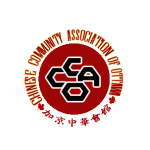
On June 7, 1980, the biennial re-election of the Board of Directors of CCAO was held as scheduled, resulting in 27 directors out of 47 candidates. 9 executive members were also elected on June 15. This time, 658 voters participated in the election, a 70% increase over the previous election, which was the highest voting record in the history of CCAO. The votes for the elected members are as follows.
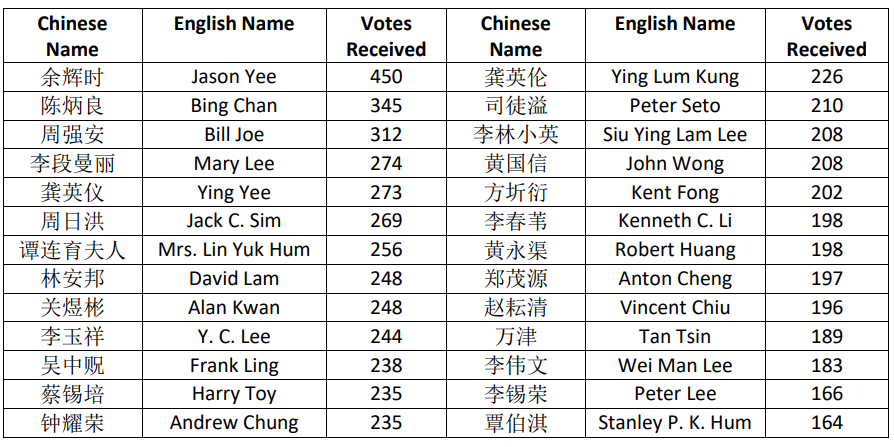
There are only 26 board members in the Chinese-Canadian Community News, leaving out one. The nine executive directors are
President: Jason Yee
First Vice President: Bing Chan, in charge of “Chinese-Canadian Community News” and internal special events
Second Vice-President: Frank Ling, in charge of “Canadian Chinese Television” and external special activities
Secretary: John Wang
Treasurer: Ying Yee
Four standing committee members: Chow Keung On, Kwan Yu Bin, Lee Lam Siu Ying, Chung Yiu Wing
Recreation Team: Stanley P. K. Hum
Youth Group: Peter Lee
Welfare group: Mrs. Lin Yuk Hum
After the re-election of the Chinese Community Association, there were different voices within the Board of Directors on whether to fund the building, and the project almost perished. The building was designed to be 8 stories high with 50 residential units, which was considered to be a standout in downtown Ottawa at the time, and the budget for the building was ¥2 million.
After many setbacks, the building finally broke ground on April 16, 1981. Mr. Bing Chan of the Chinese Community Association presided over the groundbreaking ceremony. Mr. Yunshi Yi, a member of Congress, and Mr. Jason Yee, chairperson of Zhonghua building, shovelled the symbolic first shovel of soil with a flower ball in their hands. Ottawa’s Acting Mayor Joe Casey and other prominent politicians spoke at the groundbreaking ceremony. The subsequent reception was presided over by Bill Joe, who led everyone to toast.
The final construction cost of the building was ¥1.93 million, of which the first ¥130,000 was raised through fundraising by the Chinese Community Association. The top donor, Mr. Guangming Huang and Mrs. Huang, gave $11,785, which was enough to buy a house at the time. The names of these fundraisers are engraved on a bronze plaque at the entrance of the building.
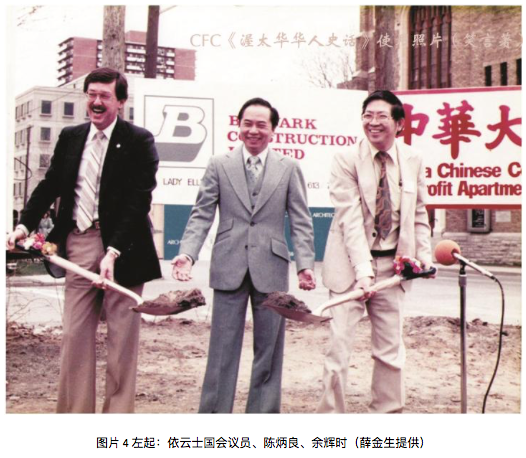
Construction of the building started in mid-April 1981 and progressed smoothly, with all construction work completed on schedule by the end of December. The funding was within budget and the fundraising was well over estimated. From a project management point of view, this is a very successful case. Twelve of the 50 units in the building got subsidies from the Ontario government, while the rent for the remaining units is slightly lower than the market price. Before that, there was a rumour that the rent of the building was too high, causing many people to take a wait-and-see attitude. However, all of the units were booked out in less than ten days after the advertisement was published in the newspaper.
The ribbon-cutting ceremony for the completion took place on April 18, 1982.
There were roughly 500 people in attendance on that day and many more guests who congratulated the completion over the phone. Additionally, the Zhonghua building received many congratulatory gifts, such as congratulatory messages, flower baskets, mirror screens, calligraphy and painting, etc. The 台湾侨务委员会 presented the golden writing of Zhonghua building, and the famous Hong Kong painter Wu Yisheng presented a traditional Chinese painting. Almost all Chinese groups, Chinese schools, churches, businesses, shops and companies have been invited. The lion dance troupe of the Chinese Freemasons of Canada danced from 437 Gilmore Street, the former site of the Chinese Community Association, to the front of the Zhonghua building at 80 Florence Street. In the warm applause of the audience, the lion danced up and down, left and right, then the dancing lion practiced caiqing (“puck the greens”), and presented a flag and a speech to Mr. Jason Yee, chairperson of the Chinese Community Association.
The opening ceremony was jointly presided over by the building’s chairperson Jason Yee, Secretary Bing Chan, and Bill Joe. The Chinese Community Association’s chairperson, Jason Yee, and vice-chairperson, Bing Chan, held the ribbon, which was cut by representatives from the federal, provincial, and municipal governments like MP Mr. Evans, Ontario Ministry of Municipal Affairs and Housing Mr. Bennett Ottawa Mayor Dewar.
In her speech, Mayor Dewar said that she was very happy and excited to see that the Ottawa Chinese had successfully completed a very meaningful project. She also said that Ottawa’s Chinese could become a model for other ethnic groups.
“When drinking water, one should not forget its source.” We should be grateful to everyone that brought us here. Bing Chan, the first vice-chairperson of the Chinese Community Association, thanked the previous chairpersons of the Chinese Community Association, including Jack Sim, Joe G. Hum, Bill Joe, Donald Sim, Paul Lee, Ying Yee King and Ron Kung. The Chinese Community Association awarded four permanent honorary directors: Jack Sim, Donald Sim, Joe G. Hum and Paul Lee.
This day is a festival for Ottawa Chinese.
